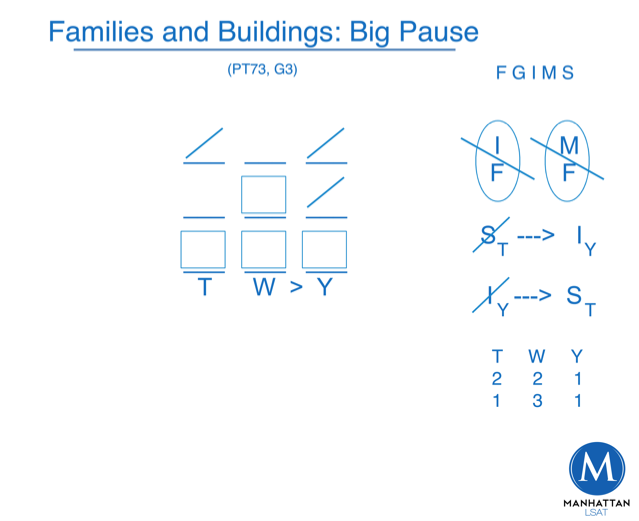
LSAT Forum
3 postsPage 1 of 1
-

- ManhattanPrepLSAT1
-
Thanks Received: 1909
-
Atticus Finch

- Posts: 2851
- Joined: October 07th, 2009
-

- OliviaF872
-
Thanks Received: 0
-
Vinny Gambini

- Posts: 3
- Joined: August 08th, 2020
Re: Diagram
Can someone explain the last rule?
"Either T owns the stable or Y owns the inn, or both."
The "or both" part threw me off. How do you diagram that?
"Either T owns the stable or Y owns the inn, or both."
The "or both" part threw me off. How do you diagram that?
-

- ErikR367
-
Thanks Received: 0
-
Vinny Gambini

- Posts: 2
- Joined: August 25th, 2020
Re: Diagram
OliviaF872 Wrote:Can someone explain the last rule?
"Either T owns the stable or Y owns the inn, or both."
The "or both" part threw me off. How do you diagram that?
So you can either show the rule as shown above (Which doesn't prevent the inclusion of both T owning S and Y owning I)
But what really worked for me was using that rule to draw out frames of the game.
Frame 1: S in T, and not I in Y: Inference here that I can only be in W or T, and if I is in T, then W can only have two slots, with a FM antichunk. However, I can also be in W, so we cant fill that in.
__ x x
[ ] x __
[ ] [ ] [s ]
W Y T
Frame 2: I in Y, and not S in T: Inference here is that Y is all filled up (Because of the numerical distributions above), thus S must go in W. Keep in Mind the FM antichunk, split between W and T, and a G floater that can go in any group but Y.
__ X X
[f/m] X __
[S] [I] [m/f]
W Y T
and Frame 3: Both I in Y and S in T : Same inferences as Frame 2: But one more..... We now know have defined all the slots! Since S must go into T, and MF must still be seperate, we know T has to own 2 properties. Since W has to own more than Y, it owns 2, and G must fill in the last spot for W.
[G] X [F/m]
[m/f] [I] [s]
W Y T
Now my first time through, I actually didn't pick up on the FM antichunk the first time around, and so my frames were a lot more open going through the game, which ate up a lot of time. But with a good reading of the rules the first time around, These frames would make the following questions a cinch.
3 posts Page 1 of 1